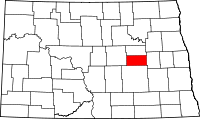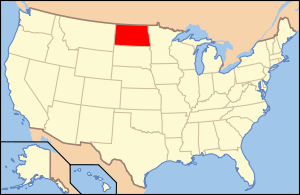Foster County, North Dakota
| Foster County, North Dakota | |
|---|---|
 Foster County Courthouse in Carrington, North Dakota. | |
 Location in the U.S. state of North Dakota | |
 North Dakota's location in the U.S. | |
| Founded | October 11, 1883 |
| Seat | Carrington |
| Largest city | Carrington |
| Area | |
| • Total | 647 sq mi (1,676 km2) |
| • Land | 635 sq mi (1,645 km2) |
| • Water | 11 sq mi (28 km2), 1.8% |
| Population (est.) | |
| • (2016) | 3,303 |
| • Density | 5.3/sq mi (2.0/km2) |
| Congressional district | At-large |
| Time zone | Central: UTC−6/−5 |
| Website |
www |
Foster County is a county located within the U.S. state of North Dakota. As of the 2010 census, the population was 3,343.[1] Its county seat is Carrington.[2] The county was founded in 1873 and later organized in 1883.[3][4] It was named for George I. Foster, a pioneer and member of the Territorial legislature.[5]
Geography
According to the U.S. Census Bureau, the county has a total area of 647 square miles (1,680 km2), of which 635 square miles (1,640 km2) is land and 11 square miles (28 km2) (1.8%) is water.[6] It is the second-smallest county in North Dakota by area.
Major highways
Adjacent counties
- Eddy County (north)
- Griggs County (east)
- Stutsman County (south)
- Wells County (west)
National protected area
Demographics
| Historical population | |||
|---|---|---|---|
| Census | Pop. | %± | |
| 1880 | 37 | — | |
| 1890 | 1,210 | 3,170.3% | |
| 1900 | 3,770 | 211.6% | |
| 1910 | 5,313 | 40.9% | |
| 1920 | 6,108 | 15.0% | |
| 1930 | 6,353 | 4.0% | |
| 1940 | 5,824 | −8.3% | |
| 1950 | 5,337 | −8.4% | |
| 1960 | 5,361 | 0.4% | |
| 1970 | 4,832 | −9.9% | |
| 1980 | 4,611 | −4.6% | |
| 1990 | 3,983 | −13.6% | |
| 2000 | 3,759 | −5.6% | |
| 2010 | 3,343 | −11.1% | |
| Est. 2016 | 3,303 | [7] | −1.2% |
| U.S. Decennial Census[8] 1790-1960[9] 1900-1990[10] 1990-2000[11] 2010-2016[1] | |||
2000 census
As of the census of 2000, there were 3,759 people, 1,540 households, and 1,031 families residing in the county. The population density was 2/km² (6/sq mi). There were 1,793 housing units at an average density of 1/km² (3/sq mi). The racial makeup of the county was 99.02% White, 0.13% Black or African American, 0.43% Native American, 0.05% from other races, and 0.37% from two or more races. 0.19% of the population were Hispanic or Latino of any race. 43.1% were of German, 31.0% Norwegian and 5.4% Irish ancestry.
There were 1,540 households out of which 31.00% had children under the age of 18 living with them, 57.50% were married couples living together, 6.40% had a female householder with no husband present, and 33.00% were non-families. 30.60% of all households were made up of individuals and 16.00% had someone living alone who was 65 years of age or older. The average household size was 2.39 and the average family size was 2.99.
In the county, the population was spread out with 26.20% under the age of 18, 5.50% from 18 to 24, 25.90% from 25 to 44, 21.00% from 45 to 64, and 21.40% who were 65 years of age or older. The median age was 40 years. For every 100 females there were 98.80 males. For every 100 females age 18 and over, there were 95.80 males.
The median income for a household in the county was $32,019, and the median income for a family was $40,469. Males had a median income of $31,442 versus $19,750 for females. The per capita income for the county was $17,928. About 7.60% of families and 9.30% of the population were below the poverty line, including 10.90% of those under age 18 and 12.40% of those age 65 or over.
2010 census
As of the 2010 United States Census, there were 3,343 people, 1,495 households, and 930 families residing in the county.[12] The population density was 5.3 inhabitants per square mile (2.0/km2). There were 1,801 housing units at an average density of 2.8 per square mile (1.1/km2).[13] The racial makeup of the county was 98.4% white, 0.6% American Indian, 0.1% black or African American, 0.1% Asian, 0.2% from other races, and 0.5% from two or more races. Those of Hispanic or Latino origin made up 0.9% of the population.[12] In terms of ancestry, 54.2% were German, 35.9% were Norwegian, 9.8% were Irish, 5.8% were American, and 5.1% were Swedish.[14]
Of the 1,495 households, 23.7% had children under the age of 18 living with them, 53.4% were married couples living together, 5.5% had a female householder with no husband present, 37.8% were non-families, and 33.5% of all households were made up of individuals. The average household size was 2.20 and the average family size was 2.81. The median age was 46.7 years.[12]
The median income for a household in the county was $41,066 and the median income for a family was $55,278. Males had a median income of $40,076 versus $29,189 for females. The per capita income for the county was $27,945. About 3.4% of families and 7.3% of the population were below the poverty line, including 5.2% of those under age 18 and 13.4% of those age 65 or over.[15]
Communities
Cities
- Carrington (county seat)
- Glenfield
- Grace City
- McHenry
Townships
- Birtsell
- Bordulac
- Bucephalia
- Carrington
- Eastman
- Estabrook
- Florance
- Glenfield
- Haven
- Larrabee
- Longview
- McHenry
- McKinnon
- Melville
- Nordmore
- Rolling Prairie
- Rose Hill
- Wyard
Unincorporated communities
Politics
| Year | Republican | Democratic | Third parties |
|---|---|---|---|
| 2016 | 72.2% 1,241 | 20.2% 347 | 7.6% 131 |
| 2012 | 61.2% 1,030 | 36.1% 607 | 2.7% 45 |
| 2008 | 55.4% 914 | 41.6% 687 | 3.0% 50 |
| 2004 | 69.0% 1,219 | 29.3% 518 | 1.6% 29 |
| 2000 | 67.2% 1,172 | 27.2% 474 | 5.6% 97 |
| 1996 | 45.9% 801 | 38.1% 664 | 16.0% 279 |
| 1992 | 41.4% 803 | 29.1% 565 | 29.5% 572 |
| 1988 | 58.8% 1,218 | 40.4% 837 | 0.7% 15 |
| 1984 | 64.2% 1,422 | 34.6% 765 | 1.2% 27 |
| 1980 | 66.6% 1,534 | 25.5% 586 | 8.0% 183 |
| 1976 | 48.6% 1,120 | 49.8% 1,147 | 1.7% 38 |
| 1972 | 60.3% 1,352 | 38.4% 861 | 1.3% 30 |
| 1968 | 52.3% 1,119 | 41.9% 897 | 5.8% 123 |
| 1964 | 41.3% 927 | 58.6% 1,315 | 0.1% 2 |
| 1960 | 53.3% 1,351 | 46.7% 1,182 | |
| 1956 | 53.5% 1,234 | 46.1% 1,062 | 0.4% 10 |
| 1952 | 64.2% 1,558 | 35.5% 862 | 0.3% 8 |
| 1948 | 44.8% 938 | 52.0% 1,089 | 3.2% 66 |
| 1944 | 44.4% 891 | 54.9% 1,102 | 0.7% 14 |
| 1940 | 43.2% 1,109 | 56.3% 1,446 | 0.5% 12 |
| 1936 | 24.8% 685 | 68.7% 1,894 | 6.5% 180 |
| 1932 | 24.7% 609 | 74.4% 1,838 | 1.0% 24 |
| 1928 | 49.0% 1,137 | 50.8% 1,178 | 0.3% 6 |
| 1924 | 45.1% 922 | 14.1% 287 | 40.8% 834 |
| 1920 | 79.0% 1,583 | 18.5% 371 | 2.5% 50 |
| 1916 | 44.5% 549 | 53.6% 662 | 1.9% 24 |
| 1912 | 30.0% 285 | 42.4% 403 | 27.7% 263 |
| 1908 | 56.0% 569 | 42.7% 434 | 1.3% 13 |
| 1904 | 71.7% 618 | 25.9% 223 | 2.4% 21 |
| 1900 | 61.5% 415 | 35.7% 241 | 2.8% 19 |
See also
References
- 1 2 "State & County QuickFacts". United States Census Bureau. Archived from the original on July 10, 2011. Retrieved October 31, 2013.
- ↑ "Find a County". National Association of Counties. Archived from the original on 2011-05-31. Retrieved 2011-06-07.
- ↑ "Dakota Territory, South Dakota, and North Dakota: Individual County Chronologies". Dakota Territory Atlas of Historical County Boundaries. The Newberry Library. 2006. Retrieved February 3, 2015.
- ↑ "County History". North Dakota.gov. The State of North Dakota. Retrieved February 3, 2015.
- ↑ Gannett, Henry (1905). The Origin of Certain Place Names in the United States. Govt. Print. Off. p. 130.
- ↑ "2010 Census Gazetteer Files". United States Census Bureau. August 22, 2012. Archived from the original on January 29, 2015. Retrieved January 28, 2015.
- ↑ "Population and Housing Unit Estimates". Retrieved June 9, 2017.
- ↑ "U.S. Decennial Census". United States Census Bureau. Archived from the original on May 12, 2015. Retrieved January 28, 2015.
- ↑ "Historical Census Browser". University of Virginia Library. Retrieved January 28, 2015.
- ↑ Forstall, Richard L., ed. (March 27, 1995). "Population of Counties by Decennial Census: 1900 to 1990". United States Census Bureau. Retrieved January 28, 2015.
- ↑ "Census 2000 PHC-T-4. Ranking Tables for Counties: 1990 and 2000" (PDF). United States Census Bureau. April 2, 2001. Retrieved January 28, 2015.
- 1 2 3 "DP-1 Profile of General Population and Housing Characteristics: 2010 Demographic Profile Data". United States Census Bureau. Retrieved 2016-03-14.
- ↑ "Population, Housing Units, Area, and Density: 2010 - County". United States Census Bureau. Retrieved 2016-03-14.
- ↑ "DP02 SELECTED SOCIAL CHARACTERISTICS IN THE UNITED STATES – 2006-2010 American Community Survey 5-Year Estimates". United States Census Bureau. Retrieved 2016-03-14.
- ↑ "DP03 SELECTED ECONOMIC CHARACTERISTICS – 2006-2010 American Community Survey 5-Year Estimates". United States Census Bureau. Retrieved 2016-03-14.
- ↑ Leip, David. "Dave Leip's Atlas of U.S. Presidential Elections". uselectionatlas.org. Retrieved 2018-04-12.
External links
| Wikivoyage has a travel guide for Foster County (North Dakota). |
